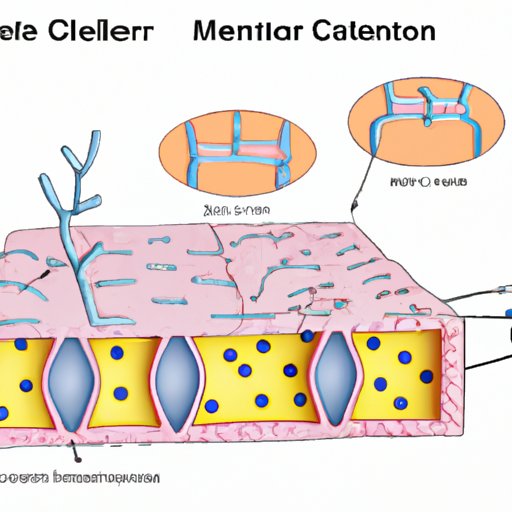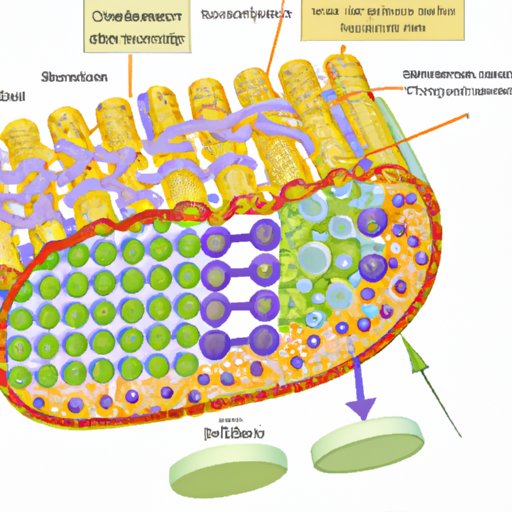Introduction
The cell membrane is a crucial component of all living cells. It separates the interior of a cell from its external environment and regulates the passage of molecules in and out of the cell. A better understanding of the cell membrane is essential for comprehending cell function and how various substances enter and exit the cell. This article explores the composition and molecular structure of the cell membrane, breaking down its key building blocks and components, and highlighting their functions.
Exploring the Composition of Cell Membranes: What Science Reveals
Research has shown that the cell membrane comprises various molecules, including lipids, proteins, and carbohydrates. Scientists have used multiple methods, such as microscopy and chemical analysis, to study the molecular structure of the cell membrane.
Notable findings include understanding the interconnectedness of different components and how specific molecules, such as lipids, play crucial roles in cell membrane formation and function.
Breaking Down the Building Blocks of the Cell Membrane
Lipids are essential building blocks of the cell membrane, contributing to its fluidity and permeability. The most common lipids found in the cell membrane are phospholipids, which are made up of a hydrophobic tail and a hydrophilic head and form a lipid bilayer.
Proteins and carbohydrates also play vital roles in cell membrane composition. Proteins act as gatekeepers, regulating the passage of molecules across the membrane, while carbohydrates help with cell recognition and communication.

The Intricacies of the Cell Membrane: Understanding Its Structure
The Fluid Mosaic Model describes the structure of the cell membrane, which consists of a lipid bilayer with embedded proteins and other molecules. The lipid bilayer is composed of a phospholipid bilayer, which spontaneously forms due to the hydrophobic and hydrophilic nature of its components.
Membrane proteins are integral to the function of the cell membrane. They can be embedded entirely within the lipid bilayer or attach to one of its surfaces. Some membrane proteins act as channels, allowing the passage of specific molecules, while others act as receptors, receiving signals from the external environment.
Unpacking the Cell Membrane: An Insider’s Guide to Composition
Understanding the lipid composition of the cell membrane is crucial for comprehending its function. The lipid composition of the cell membrane can vary according to the cell’s specific needs, but generally, it is composed of phospholipids, glycolipids, and cholesterol.
Proteins are also vital components of the cell membrane, with various functions like acting as enzymes or transporting molecules across the cell membrane. Carbohydrates on the cell surface help identify cells and facilitate cell-to-cell communication.
Discovering the Molecular Makeup of the Cell Membrane
The cell membrane’s molecular makeup consists of various molecules with specific chemical properties and functions. The hydrophobic and hydrophilic properties of phospholipids play a crucial role in the formation of the lipid bilayer, while cholesterol contributes to cell membrane stability and fluidity.
Glycolipids are carbohydrates attached to lipids and are essential in cell-to-cell communication, while membrane proteins can be categorized into channels, receptors, and enzymes, regulating various cell functions.
The Components of the Cell Membrane: A Comprehensive Overview
The cell membrane’s components, lipids, proteins, and carbohydrates, are interconnected, with each component playing a vital role in cell membrane function. Lipids, specifically phospholipids, form the lipid bilayer, while proteins embedded in the lipid bilayer regulate various functions like transport or communication.
Carbohydrates on the cell surface identify cells and help with cellular communication. Overall, understanding the importance of each component is crucial in understanding how the cell membrane functions.
What Lies Within: The Fascinating Elements that Make Up the Cell Membrane
The diverse range of molecules that make up the cell membrane contributes to its unique properties and functions. The molecular composition of the cell membrane varies according to the cell’s specific needs, but the key components remain lipids, proteins, and carbohydrates.
A deeper understanding of these molecules and their properties is crucial in comprehending the intricacies of the cell membrane and its vital role in cell function and communication.
Conclusion
In summary, the cell membrane is composed of various molecules, each playing a crucial role in cell membrane formation and function. The molecular composition of the cell membrane and its intricate structure determine its unique properties and facilitate cell-to-cell communication.
Therefore, it is essential to understand the components and molecular structure of the cell membrane to comprehend its function fully and how substances enter and exit the cell. This knowledge can provide breakthroughs in medicine and biotechnology, leading to innovative research on cell function and disease.
